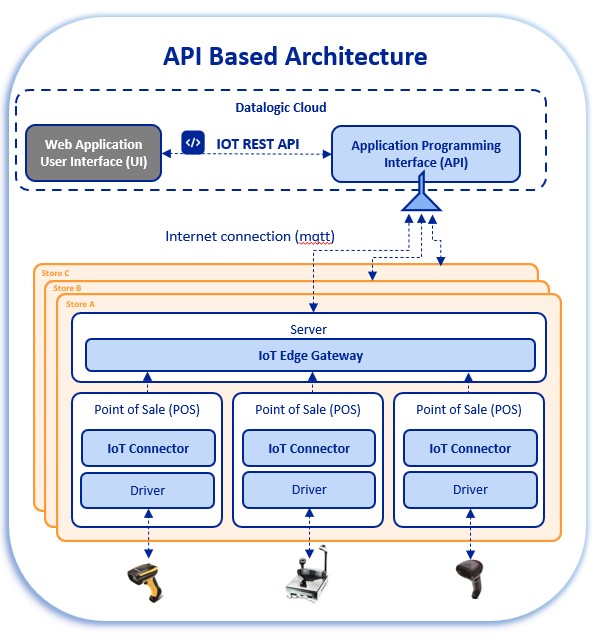Datalogic Datalogic IoT Platform is built on a modern microservices architecture that provides scalability, flexibility, and reliability for your IoT applications. The platform is designed to handle large volumes of data, support real-time analytics, and integrate with a wide range of devices and protocols.
API Based Architecture
The architecture diagram showcases an API-Based Architecture designed for managing and connecting IoT devices in multiple retail stores using a centralized cloud solution.

Components Overview
- Web Application User Interface (UI):
- Provides a user-friendly interface for interacting with the system.
- Enables monitoring and management of devices and stores.
- IoT REST API:
- Acts as the primary communication layer between the UI and the backend services.
- Facilitates data exchange and control commands between the cloud and IoT infrastructure.
Internet Connection (MQTT)
- MQTT Protocol:
- Ensures lightweight, real-time communication between the cloud and IoT Edge Gateways in stores.
- Provides reliable messaging over the Internet.
3. Store Infrastructure
Each store (e.g., Store A, Store B, Store C) operates independently but connects to the centralized cloud via the following components:
a. IoT Edge Gateway
- A server located in each store.
- Acts as a bridge between the cloud and the local devices.
- Facilitates communication and data processing locally.
b. Point of Sale (POS)
- Multiple POS systems are deployed in each store.
- Each POS system contains:
- IoT Connector:
- Manages communication between the POS system and connected IoT devices.
- Driver:
- Facilitates device-specific communication.
- IoT Connector:
4. IoT Devices
- Devices like Datalogic handheld scanners, fixed retail scanners and other Datalogic devices are connected to the POS systems.
- These devices interact with the IoT Connector and Driver for smooth operation.
Workflow Summary
-
Cloud Communication:
- The Web Application UI interacts with the Datalogic Cloud APIs to issue commands and retrieve data.
- Data is transmitted securely over the Internet using the MQTT protocol.
-
Store Communication:
- The IoT Edge Gateway in each store receives messages from the cloud.
- The gateway processes and routes these messages to the appropriate POS system.
-
Device Interaction:
- Each POS system communicates with connected IoT devices through the IoT Connector and Driver.
- Devices perform actions or return data based on the received commands.
Key Features
- Centralized Management:
- Enables the cloud-based monitoring and control of IoT devices across multiple stores.
- Real-Time Communication:
- MQTT ensures efficient and reliable message delivery between the cloud and stores.
- Scalability:
- Easily accommodates additional stores or devices without significant architectural changes.
Use Cases
- Retail Operations:
- Managing point-of-sale systems and associated IoT devices in retail environments.
- Device Monitoring:
- Centralized oversight and diagnostics of IoT devices.
- Remote Configuration:
- Deploying updates or configuration changes to stores from the cloud.
IoT Connector
The IoT Connector is a critical component that enables communication between the POS system and connected IoT devices. It acts as a bridge for data exchange and control commands, ensuring seamless integration and operation of the IoT ecosystem.